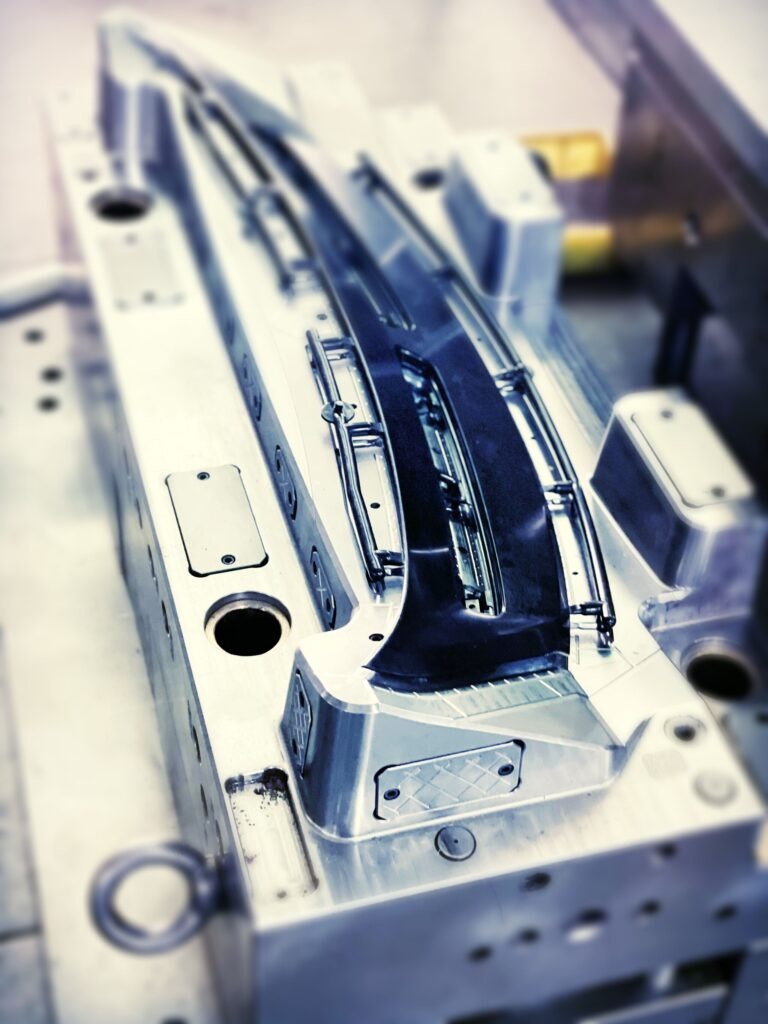Producing a 40-tonne plastic injection mould tool for a vehicle bumper is a complex, multi-disciplinary process that demands careful planning, precision engineering, and collaboration across multiple departments. Here’s a breakdown of the key stages involved in making this crucial component for automotive manufacturing:
1. Understanding the Design Requirements
The first step is aligning the bumper design with both aesthetic and functional needs. Automotive bumpers must meet stringent safety, aerodynamics, and durability standards. This involves working closely with design and simulation teams to ensure the part will perform under various stress conditions (impact, temperature changes, etc.) while keeping the vehicle’s visual identity intact.
Key questions:
- What are the specific design tolerances?
- What materials (e.g., polypropylene blends) best suit the design requirements?
- How will this part interact with the vehicle’s structure in case of impact?
2. Material Selection for the Tool
The mould tool itself must be made from durable, high-strength materials capable of withstanding repeated injection cycles under high pressures and temperatures. For a tool this size, tool steels like H13 or P20 are often preferred due to their ability to resist wear and maintain dimensional stability over time.
Considerations:
- Tool steel grade selection for hardness and longevity.
- Cooling channels for efficient heat dissipation to minimize cycle time and prevent part warpage.
- Optimising the tool’s design for high-volume production—potentially millions of parts.
3. Mould Design
Creating the design of the injection mould tool involves considering the parting line, ejection systems, and gating locations. For a large and complex part like a bumper, ensuring uniform material flow is critical to avoid defects like sink marks, warpage, or incomplete fills.
Key focus areas:
- Runner system design: The positioning of the gates must ensure smooth material flow into the cavity, minimizing stress points.
- Cavity balance: To achieve even material distribution across the tool.
- Ejection system: Bumpers are large, flexible parts that require careful planning in terms of ejector pin positioning to avoid deforming the part during removal.
4. Thermal Management & Cooling Systems
A major consideration for a large tool is cooling system design. Efficient heat removal from the tool ensures the proper curing of the plastic while reducing cycle times, which is crucial for high-volume production.
Thought process:
- Designing optimal cooling channels in both core and cavity.
- Balancing cooling efficiency with the structural integrity of the tool.
5. Mould Manufacturing
Once the design is finalized, tool machining begins. Given the size (40 tonnes), the milling and EDM (Electrical Discharge Machining) processes require heavy-duty CNC machines capable of handling large, complex parts with extremely tight tolerances. Surface finish is critical, especially for visible exterior parts like bumpers.
Considerations:
- Machining large core and cavity inserts requires precision over extended work periods, often with multi-axis CNC equipment.
- Fine-tuning details, such as textures or logos, requires high-precision engraving techniques.
- Trial runs to check for any potential mould defects or part issues before committing to full production.
6. Tool Assembly & Testing
After manufacturing, the mould components are assembled, and the tool undergoes testing and validation. This includes injecting plastic under production conditions to identify and resolve any issues related to part quality, cycle times, or tool wear.
Checklist for testing:
- Verify dimensional accuracy of the bumper after injection.
- Check for surface defects like sink marks, flash, or flow lines.
- Optimize injection parameters (e.g., temperature, pressure) for consistent part quality.
7. Maintenance Planning
A tool of this size, given its workload in high-volume automotive production, requires a long-term maintenance strategy to keep it running efficiently. Predictive maintenance and regular inspections are essential to avoid downtime and costly repairs.
Considerations:
- Establishing an inspection routine based on the number of cycles.
- Planning for spare parts for high-wear components (e.g., ejector pins, inserts).
- Implementing a preventative maintenance schedule to ensure longevity.
8. Sustainability & Cost Management
Large bumper moulds are high-investment tools. Balancing tool longevity with initial cost and operational efficiency is critical for profitability. Decisions around cycle time, material choice, and manufacturing processes must all consider their cost impact while also minimizing the environmental footprint through efficient material usage and energy consumption.
Building a 40-tonne plastic injection mould tool for automotive bumpers is a highly strategic process. It involves not only cutting-edge technology but also deep industry expertise to ensure that the final tool delivers consistent, high-quality results at a pace that meets the demands of global automotive production.


